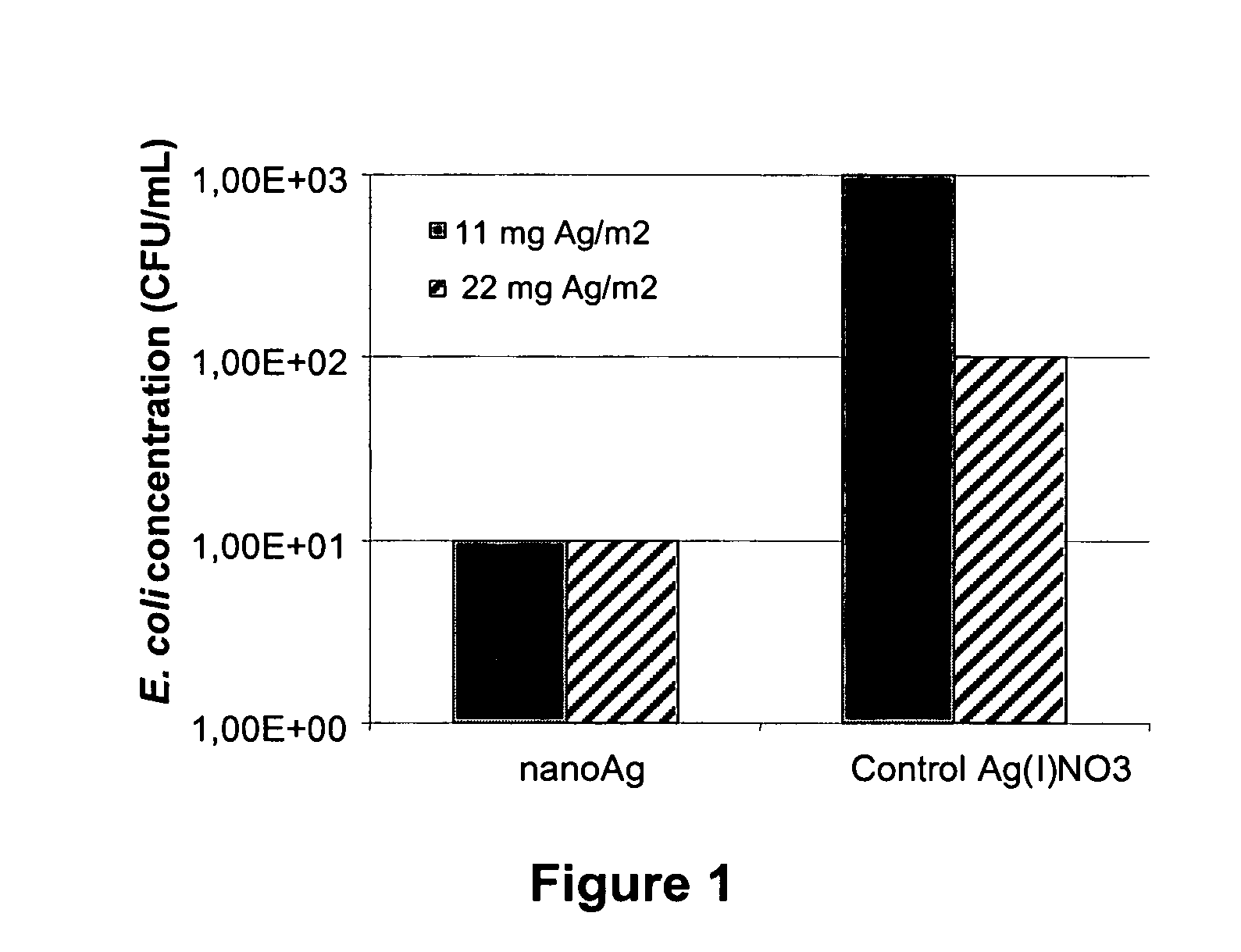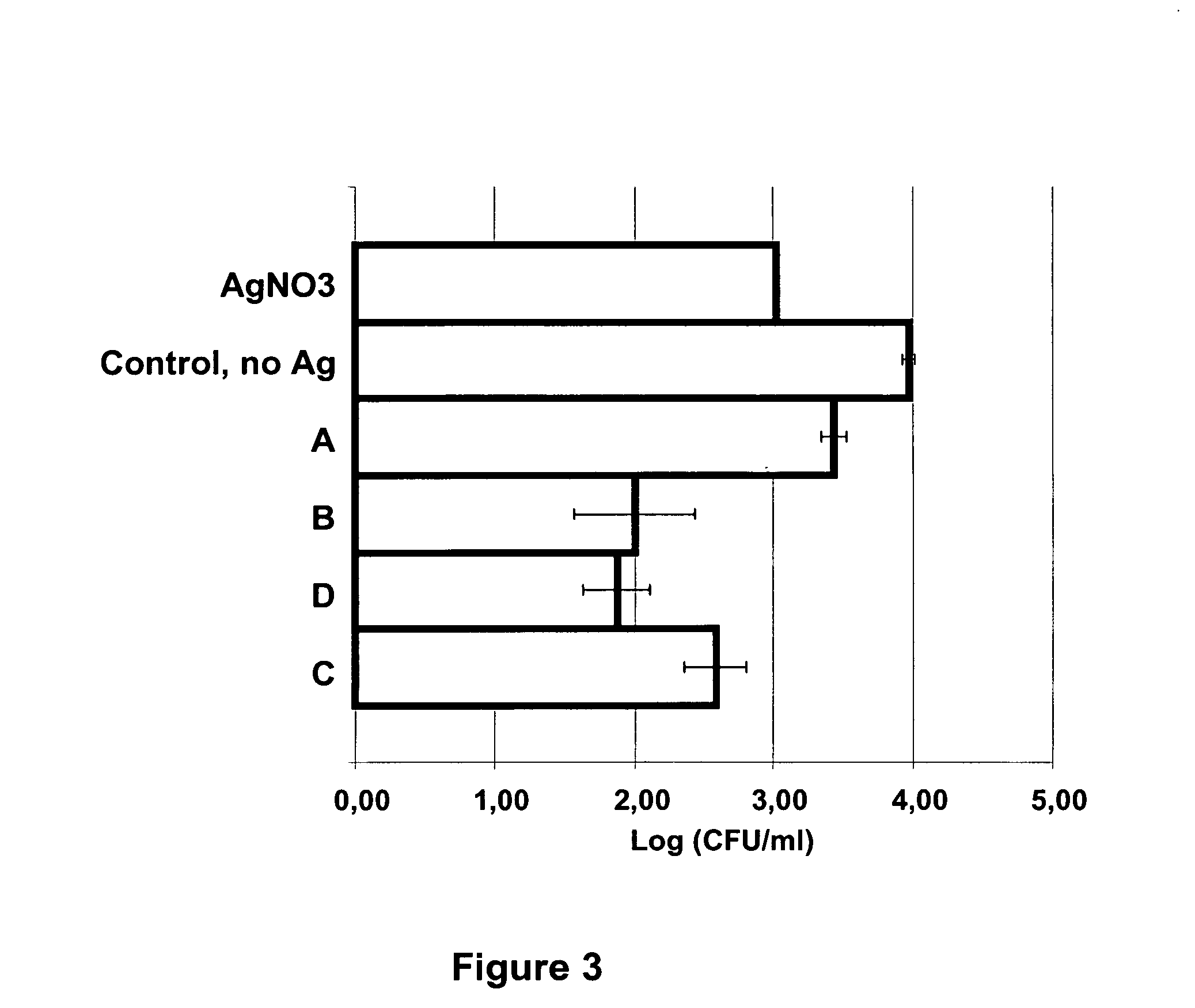Method for producing metal nanoparticles
a metal nanoparticle and metal nanoparticle technology, applied in the direction of antibacterial agents, biocide, microorganisms, etc., can solve the problems of reducing the effect of germ count, requiring both expensive equipment and substantial electricity costs, and requiring many hours or additional ultraviolet radiation, so as to reduce the need for potentially toxic and/or expensive chemicals, the effect of low cost and high reliability
- Summary
- Abstract
- Description
- Claims
- Application Information
AI Technical Summary
Benefits of technology
Problems solved by technology
Method used
Image
Examples
example 1
Preparation of Nanosilver
[0089]A culture of Lactobacillus fermentum Beijerinck 1901 AL (ATCC 11976, LMG 8900, from intestine of an 8-days old breast fed infant) was propagated in MRS broth (commercially available from Oxoid, Basingstoke, United Kingdom) under micro-aerophilic conditions at 37° C. for 15 hours. Cells were harvested from MRS by centrifugation at 3,000 g for 10 minutes at 15° C. and washed 2 times with milliQ water, then re-suspended in milliQ water to a final optical density of 1.5 at 600 nm (OD600). Sodium hydroxide was added to the cell suspension from a 1 N NaOH stock solution such as to reach final concentrations of 0.05 N NaOH and 0.10 N NaOH, respectively.
[0090]An Ag (I) stock solution of 425 mg AgNO3 and 225 mg NH4Cl in 50 mL milliQ water was prepared. One volume of this Ag(I) stock solution was added to ten volumes of the cell suspensions with 0.05 and 0.10 N NaOH, respectively. These mixtures were allowed to incubate under visible light at 25° C., under mild ...
example 2
XRD Analysis of Nanosilver
[0091]X-ray diffraction (XRD) analysis of the biomass with silver particles obtained in example 1 and further dried at 30° C. was performed with a Siemens Diffractometer D5000 with Bragg-Brentano optics (commercially available from Siemens, Munich, Germany). X-rays were generated by a copper X-ray tube with power 1.6 kW (40 kV, 40 mA). Measurements were made between 25 and 90 degrees 2-theta with a tep time of 1.6 s and a step size of 0.02 degree. The resulting spectrum (not shown) indicates the presence of the X-ray diffraction pattern of silver metal and sodium oxide. The latter is a residue of the sodium hydroxide used in the preparation of the nanosilver.
example 3
EDX Analysis of Nanosilver
[0092]Energy Dispersive X-ray (EDX) analysis of dried biomass with nanosilver as obtained in example 1 and further dried at 30° C. was performed with a JSM6100 Scanning Electron Microscope with EDX detector (available from JEOL USA, Inc.) with a resolution corresponding to an incident energy of 20.0 keV. Analysis results are listed in Table 1 (both as weight % and atomic %) and clearly demonstrate the presence mainly of organic matter (due to the high content of carbon and oxygen) and silver, the combination of which amounts to about 91 weight % of the dry matter. The rest of the dried product consisted of trace elements Ca, Mg, Si, P, S and Cl mostly due to mineral residues from the dried biological matrix.
TABLE 1elementWeight %Atomic %C55.90 ± 0.28 69.18 ± 0.16 O26.21 ± 0.08 24.35 ± 0.15 Na4.97 ± 0.023.21 ± 0.00Mg0.85 ± 0.060.52 ± 0.04Si0.19 ± 0.060.10 ± 0.03P1.64 ± 0.040.79 ± 0.02S0.22 ± 0.010.11 ± 0.01Cl0.31 ± 0.03 0.13 ± 0.014Ag8.51 ± 0.201.17 ± 0.03Ca...
PUM
 Login to View More
Login to View More Abstract
Description
Claims
Application Information
 Login to View More
Login to View More - R&D
- Intellectual Property
- Life Sciences
- Materials
- Tech Scout
- Unparalleled Data Quality
- Higher Quality Content
- 60% Fewer Hallucinations
Browse by: Latest US Patents, China's latest patents, Technical Efficacy Thesaurus, Application Domain, Technology Topic, Popular Technical Reports.
© 2025 PatSnap. All rights reserved.Legal|Privacy policy|Modern Slavery Act Transparency Statement|Sitemap|About US| Contact US: help@patsnap.com



